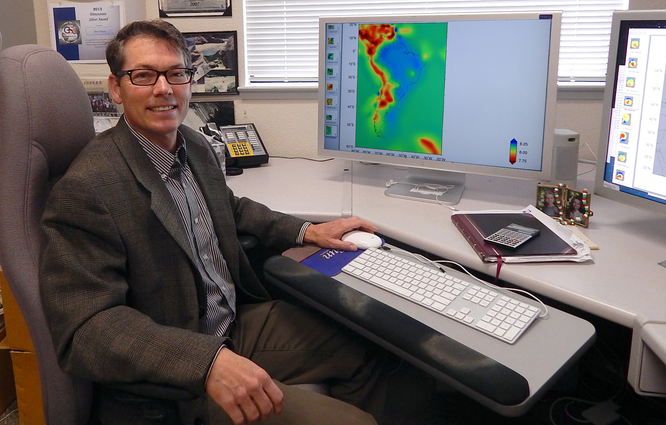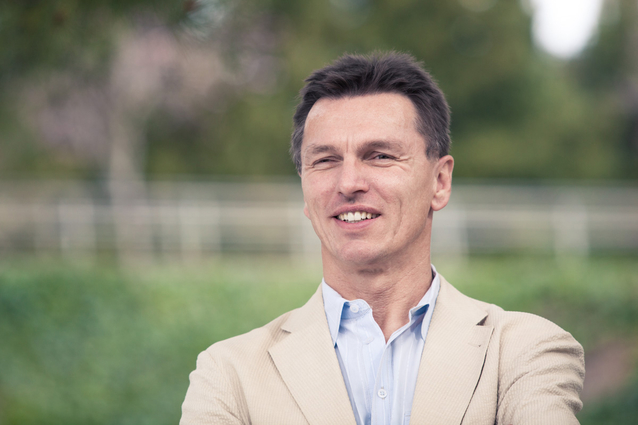Lawrence Livermore researchers win E.O. Lawrence Award
LIVERMORE, Calif. - Two Lawrence Livermore National Laboratory researchers won the prestigious Ernest Orlando Lawrence Award for their contributions to the Department of Energy's missions in science, energy and national security, DOE officials announced today.
LLNL seismologist Stephen Myers was recognized for his work advancing national security and nonproliferatio n by developing seismic monitoring technologies to locate nuclear explosions. Former LLNL scientist Siegfried Glenze r, an 18-year Lab veteran who joined the SLAC National Accelerator Laboratory at Stanford University last year, was recognized for his work advancing fusion and plasma sciences at LLNL's National Ignition Facility (NIF).
"The Lawrence Award recipients announced today have made significant contributions to the national, economic and energy security of the United States - strengthening U.S. leadership in discovery and innovation," Energy Secretary Ernest Moniz said. "I congratulate the winners and thank them for their work on behalf of the Department of Energy and the nation."
LLNL Director Bill Goldstein said the Lawrence Award recipients demonstrate the talent and innovation of Lawrence Livermore researchers and their commitment to developing groundbreaking technologies in many fields.
"I am proud of my colleagues and their scientific discoveries," Goldstein said. "This important award continues to validate the impact Lawrence Livermore researchers have made on the science and technology that enhances our national security."
Improving the accuracy of locating seismic events
Myers, who conducts research in the LLNL's Global Security program, leads a collaborative project involving a team of researchers from LLNL, Sandia and Los Alamos national laboratories, and the Air Force Technical Application Center (AFTAC).
"Steve skillfully brought together researchers from across the National Nuclear Security Administration (NNSA) laboratories and AFTAC to make a significant improvement to the U.S. capability to locate seismic events for worldwide nuclear explosion monitoring," said Jay Zucca, the deputy principal associate director for Global Security.
The team developed a technology known as the Regional Seismic Travel Time Model and Computing Code (RSTT). It improves the accuracy of locating seismic events using a 3D model of the Earth's crust and upper mantle. RSTT achieves this by analyzing regional seismic wave propagation, which varies geographically, to improve the travel time prediction of the waves.
RSTT enables the use of regional data in seismic analysis, which lowers the magnitude of events that can be detected. RSTT also reduces the search area for events by approximately a factor of 10. Those events - both past and present --- include explosions from nuclear and conventional weapons, mine explosions and earthquakes that measure a magnitude of approximately three or higher.
"It's the first time that the seismic community has tried to put together a 3D model of the earth that's specifically designed for monitoring," Myers said.
Myers, a 17-year Lab veteran, said he was extremely honored to be selected.
"I think it's a great achievement for myself and my entire research team to receive this award," he said.
Since 2010, RSTT has been used by AFTAC and the Comprehensive Nuclear-Test-Ban Treaty Organization to monitor nuclear events around the world, including North Korea. The U.S. Geological Survey's National Earthquake Information Center also is testing the technology to locate earthquakes.
"This is one technology that demonstrates how monitoring technologies have progressed since the [Comprehensive Nuclear-Test-Ban] treaty was signed," Myers said.
Advancing fusion and plasma sciences at the National Ignition Facility
Glenzer worked at Lawrence Livermore from 1995 to 2013, departing as the plasma physics group leader at NIF. He and his team developed novel Thomson X-ray scattering techniques to measure the physical properties of dense, short-lived states of matter. They used the X-ray to advance fundamental understanding of high energy density physics.
Their research aimed to understand conditions such as those found in the interiors of giant planets or in inertial confinement fusion experiments with the goal of producing a microscopic star in the lab.
"The [Lawrence] Award is a great honor - not only to me, but to all the scientists with whom I was privileged to collaborate on in our great endeavor to understand nature," Glenzer said.
He and his team performed the very first experiments on NIF, starting from NIF's early light in 2004 to full-scale inertial confinement fusion hohlraum experiments from 2008 to 2010. After the successful demonstration of the required hohlraum radiation temperature and radiation symmetry, they fielded the first implosions with thermonuclear fuel.
"Our role was to be at the forefront of new experiments on NIF with the goal to develop thermonuclear burn in the laboratory," Glenzer said.
The Lawrence Award was established to honor the memory of E.O. Lawrence, who founded Lawrence Berkeley National Laboratory and co-founded Lawrence Livermore National Laboratory.
Since 1959, the Lawrence Award has honored mid-career scientists and engineers throughout the nation who have advanced new research and scientific discovery in the chemical, biological, environmental and computer sciences; condensed matter and materials; fusion and plasma sciences; high energy and nuclear physics; and national security and nonproliferation.
In additional to Myers and Glenzer, four other researchers from DOE national labs and academia won the award. Each winner will receive a citation signed by Secretary Moniz, a gold medal bearing the likeness of E.O. Lawrence and a $20,000 honorarium.
Contact
Kenneth K Ma[email protected]
925-423-7602
Related Links
DOE press releaseStephen Myers
Siegfried Glenzer
Global Security
Natioal Ignition Facility (NIF)
SLAC






